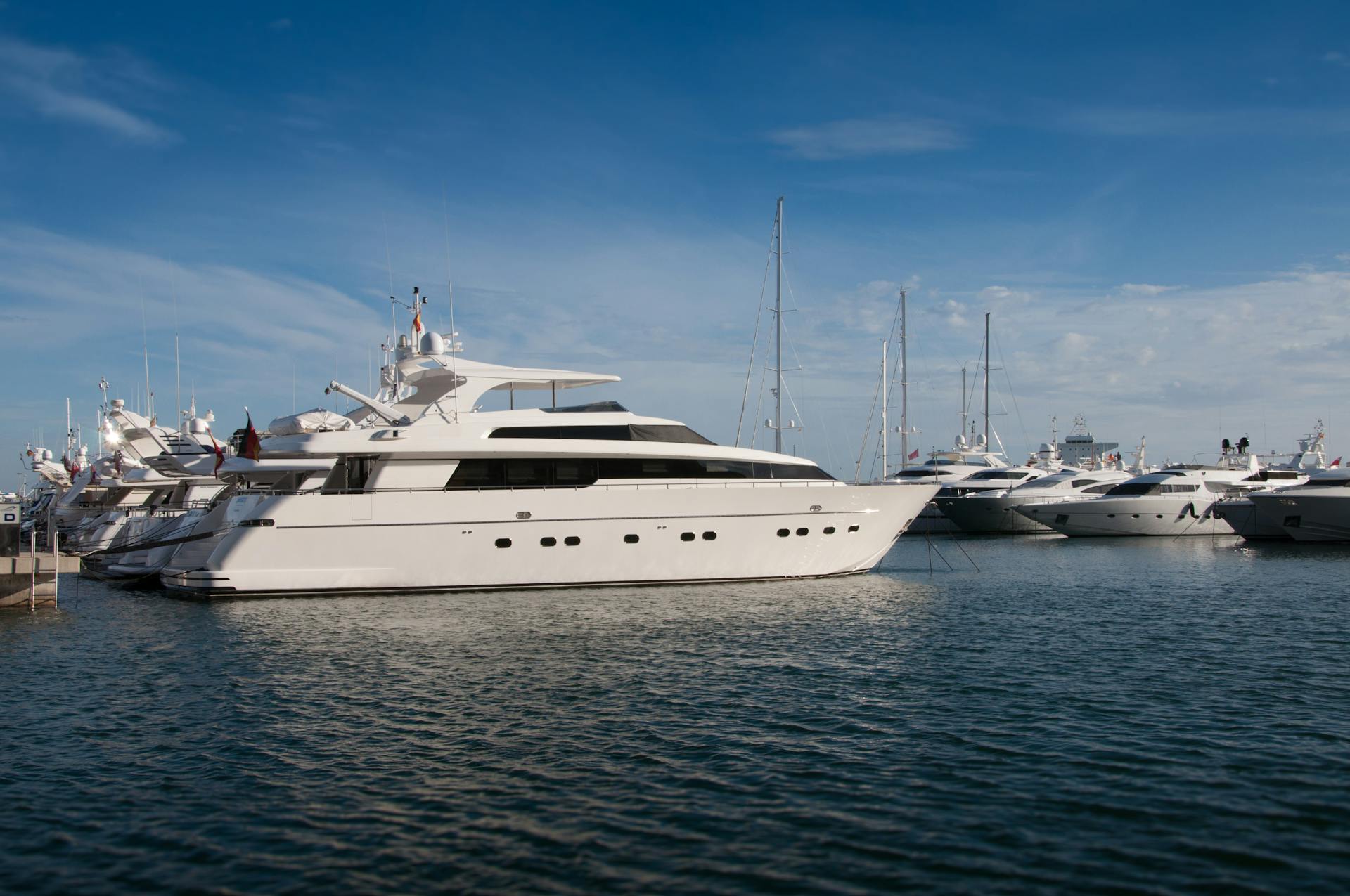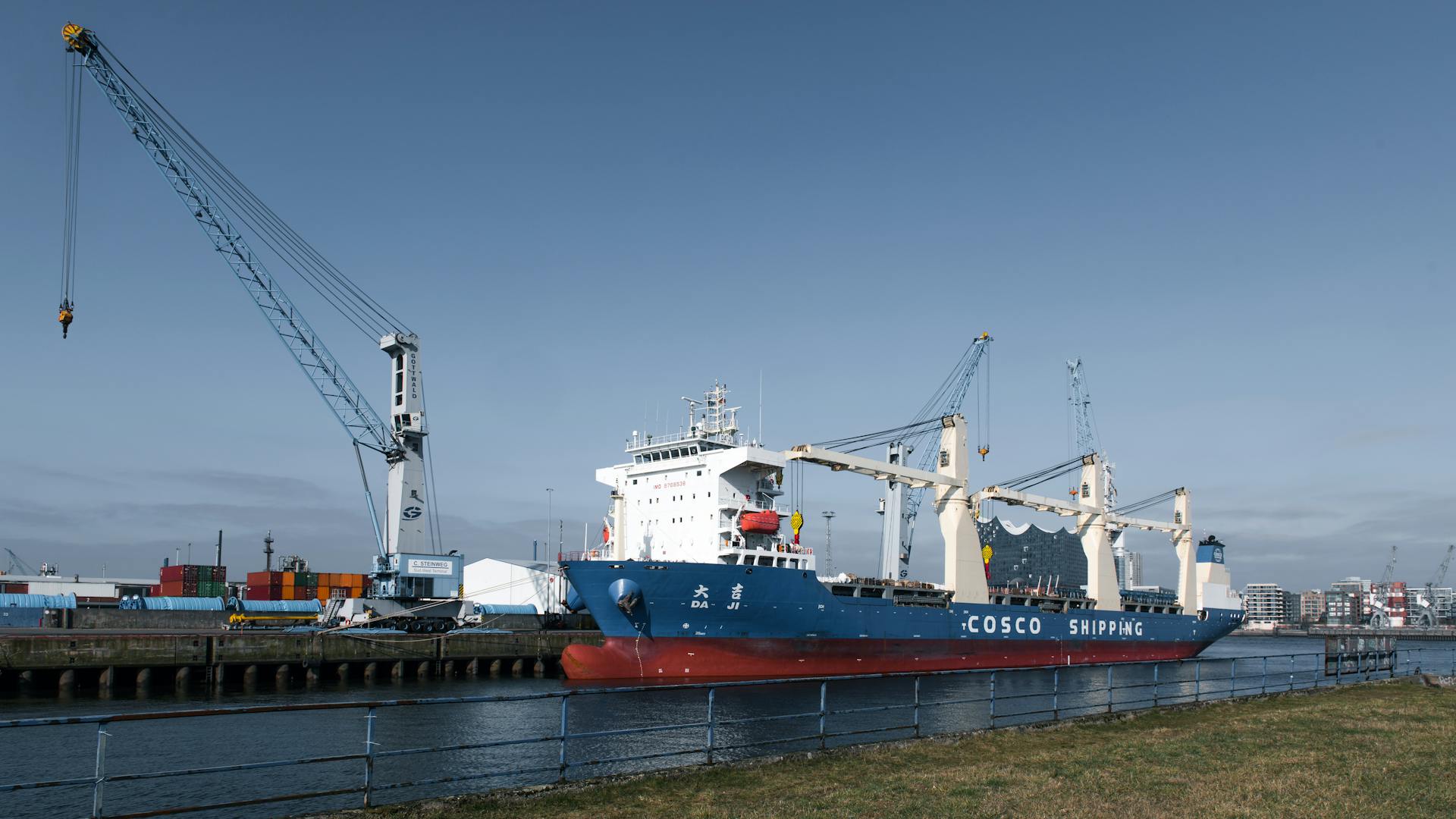
Charter shipping is a vital part of the global trade industry, allowing companies to transport goods by renting a ship or a portion of one for a specific period.
Charter shipping can be done through two main types: voyage charter and time charter. A voyage charter involves renting a ship for a single trip, while a time charter allows a company to rent a ship for a set period of time.
The charter shipping process begins with a charter party agreement, which outlines the terms and conditions of the charter. This agreement is crucial in defining the responsibilities of both the shipowner and the charterer.
The charter party agreement typically includes details such as the ship's specifications, cargo capacity, and operating costs, as well as the charterer's responsibilities for cargo handling and insurance.
For another approach, see: Cargo Ships Canada
Types of Charters
There are three primary types of ship charters: voyage charters, time charters, and bareboat charters. Each has its unique characteristics, advantages, and disadvantages.
A voyage charter is a type of charter where the shipowner agrees to transport a specific cargo from one port to another. This type of charter is often used for one-off or irregular cargo shipments.
Time charters, on the other hand, are long-term arrangements where the shipowner agrees to make a ship available to a charterer for a set period of time. This type of charter is often used for regular cargo shipments.
Bareboat charters are the most flexible type of charter, where the charterer takes full responsibility for the ship, including its operation and maintenance. This type of charter is often used for shipowners who want to earn income from their vessels without being involved in their day-to-day operation.
Here's an interesting read: Cargo Ship vs Container Ship
Charter Process
The charter process is a crucial step in charter shipping. It involves identifying the specific shipping requirements, such as type of cargo, route, and schedule.
To start, you'll need to determine your shipping requirements. This includes identifying factors like the type of cargo, route, port restrictions, and schedule. Most companies work with shipbrokers who specialize in matching charterers with ship owners.
Shipbrokers will have extensive knowledge about available ships, their condition, and the current market level for freight. They'll help you find suitable vessels based on size, quality, age, and the desired timeline.
Here are the key steps in the charter process:
- Identifying Needs
- Selecting a Broker
- Finding Potential Vessels
- Negotiating Terms
- Charter Party Agreement
The Process
The chartering process is a complex series of steps that ensures vital goods are transported efficiently around the globe. It's a process that has evolved over many centuries and continues to grow as global trade expands.
The first step in the chartering process is identifying specific shipping requirements, which involves factors such as the type of cargo, route, port restrictions, and schedule.
Most companies work with shipbrokers who specialize in matching charterers with ship owners. Shipbrokers have extensive knowledge about available ships, their condition, and the current market level for freight.
The next step is finding suitable vessels based on size, quality, age, and the desired timeline. The broker will approach the ship owners with the cargo requirement and ask for their offer.
Explore further: Chartering Company
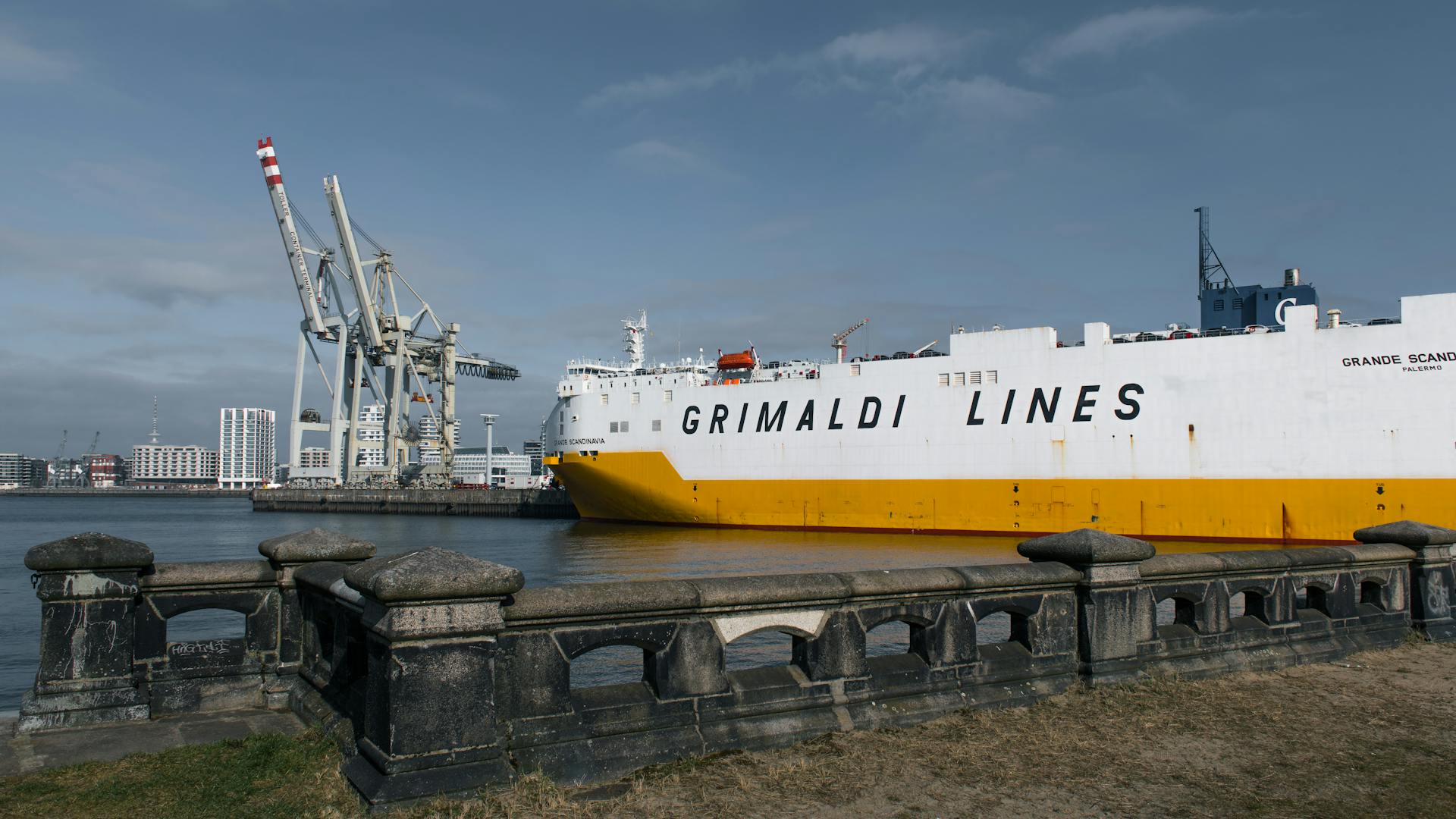
Negotiations will commence once one or more offers have been received, and the charterer will need to agree on the charter rate, laytime, demurrage, and other specific terms outlined in the charter party agreement.
Here are the key steps in the chartering process:
- Identifying Needs
- Selecting a Broker
- Finding Potential Vessels
- Negotiating Terms
- Charter Party Agreement
Round Trip
A round trip charter is a type of voyage where a ship completes a task and then returns with a new cargo. This type of charter is also known as a round-trip voyage charter.
In a round trip charter, the charter party stipulates that after completing a voyage task, a return cargo will be shipped. Sometimes, the freight will be calculated separately according to the round-trip cargo.
Round trip charters can be beneficial for both the shipowner and the charterer, as it allows for efficient use of the ship's capacity and reduces the need for separate voyages.
Consecutive Trip
Consecutive Trip charters involve shipping several voyages consecutively on the same route. This method is often adopted when the freight volume is large.
One of the advantages of this method is that the average voyage rent is lower than that of a single voyage. This can help reduce costs for the charterer.
Large freight volumes can make consecutive trips more feasible and cost-effective.
Charter Parties
Charter parties are crucial in ship charters, defining the legal duties and responsibilities of the shipowner and the charterer. They ensure all parties know their roles and the charter's terms.
A charter party must be detailed and cover all aspects of the charter, including re-renting of the vessel, type of cargo, and ports of call. It's essential to know the background of the other party, their financial standing, and business reputation.
The shipowner and charterer should be aware of the cargo-handling capacity of the vessel and its flag. This information is vital for a successful charter party or fixture.
Shipping Parties
Shipping parties play a crucial role in ship chartering. The two main players in ship chartering are the ship owner and the charterer.
The ship owner provides the means for transporting cargo, while the charterer enters into a contract with the owner to hire the ship or space in the ship for transporting their cargo. A charterer may own the cargo and employ a ship broker to find a suitable vessel.
Curious to learn more? Check out: Flight Chartering
The ship broker is essentially a middleman who connects the principals in order to earn a brokerage fee. He can represent either the owner or the charterer in negotiations and usually specializes in specific areas of cargo carrying.
Shipping agents are designated to take responsibility for handling shipments and cargoes at the ports on behalf of the owners, fleet managers, and charterers. They handle essential routine tasks, such as crew transfers and customs documentation.
Here are the main parties involved in ship chartering:
- Ship owner/Ship operator: The entity providing the ship.
- Charterer: The entity who controls the cargo and is renting the vessel for transportation.
- Ship broker: An intermediary who provides market information and connects charterers with vessel owners or operators
- Shipping agent: Responsible for handling shipments and cargoes at the ports.
Core Elements of a Party Agreement
A charter party is a contract between the shipowner and the charterer that outlines the responsibilities of both parties. It's essential to have a clear and comprehensive agreement in place to avoid any misunderstandings or disputes.
The charter party must include details about the vessel, such as its name, type, dimensions, and capacity. This information is crucial for the charterer to ensure the vessel can handle the cargo and meet their needs.
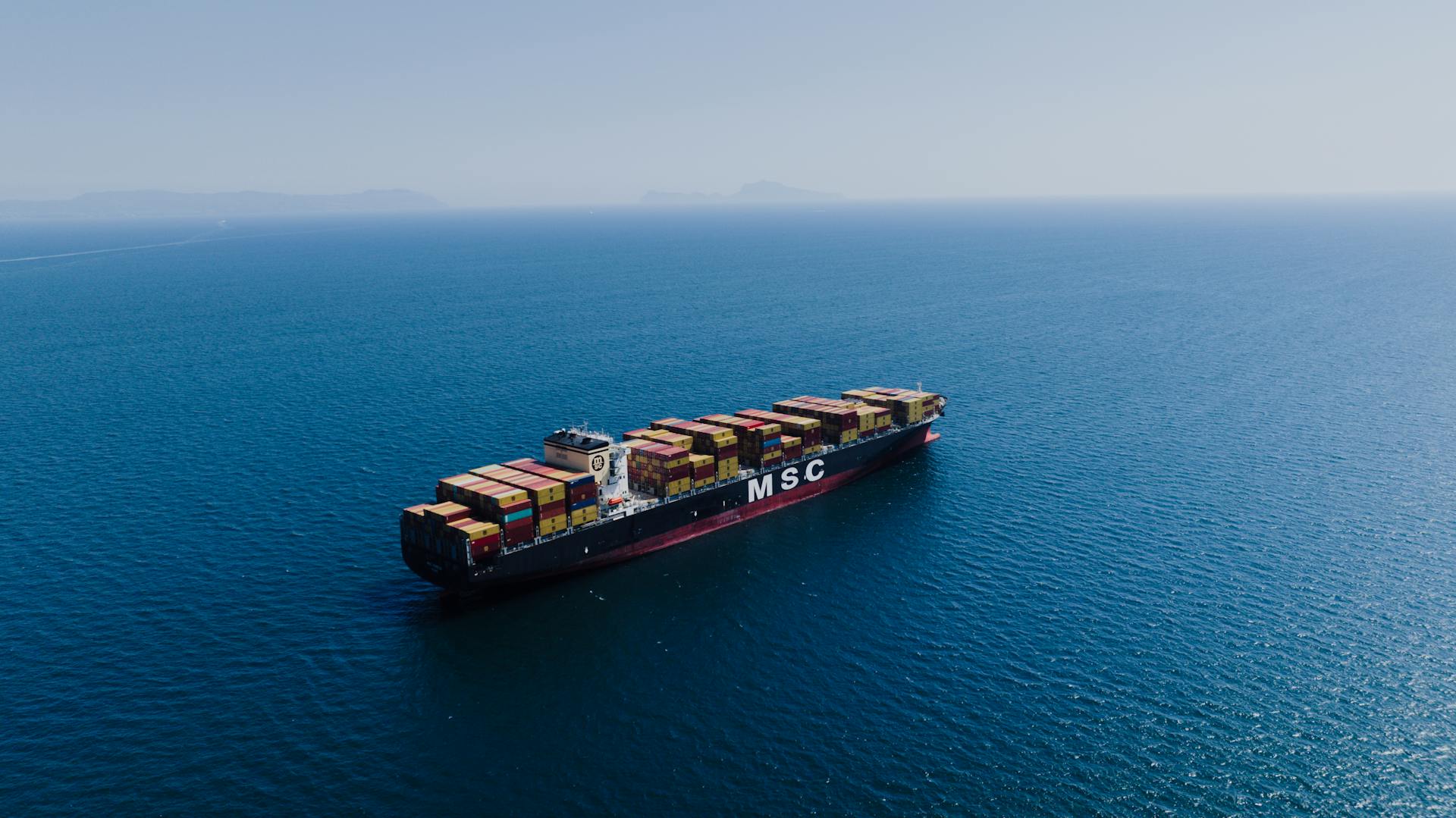
The charter duration is another critical element of a charter party. This can range from a single voyage to several years, depending on the agreement. The charterer must ensure they understand the duration of the charter and the implications for their business.
The freight or hire rate is a key component of a charter party. This is the payment the charterer makes to the shipowner for vessel use, based on tonnage, day rate, or lump sum. The charterer must carefully review the freight rate to ensure it aligns with their budget and expectations.
Cargo details, such as cargo type, quantity, and special handling needs, must also be included in the charter party. This information is vital for the shipowner to ensure they can provide the necessary equipment and personnel to handle the cargo.
The loading and discharging ports are also essential details that must be included in the charter party. This information helps the charterer plan their logistics and ensure the cargo is delivered to the correct destination.
The charter party may also include additional clauses for specific needs and trades, such as special safety measures for transporting dangerous goods or insurance and security provisions for war zone charters.
Here are the essential elements of a charter party:
The charter party must also include procedures for resolving disputes during the charter. This is essential to ensure that any issues that arise can be resolved quickly and efficiently.
Charter Types and Options
There are three main types of charter contracts: voyage charter, time charter, and demise (or bareboat) charter. Each has its own unique characteristics.
A time charter, also known as a trip charter on time basis, calculates rent based on the time required for the voyage, not including demurrage and dispatch costs. This type of charter doesn't require the ship owner to be responsible for the operation and management of cargo transportation.
The key differences between time and voyage charters are quite distinct. Here are some of the main differences:
- Duration: Time charters span a set period, while voyage charters cover a single voyage between specific ports.
- Cost allocation: Time charters have the charterer paying for fuel, port charges, and daily hire, while voyage charters have the ship owner covering port, fuel, and crew costs.
- Operational control: Time charters give charterers more control over vessel operations, while voyage charters give the ship owner more control.
- Freight rates: Time charter rates are based on a daily hire, while voyage charter rates are charged per tonne of cargo.
- Market exposure: Time charters offer insulation from market volatility, while voyage charters are more exposed to freight rate fluctuations.
Other Variations
There are several other variations of ship charters designed to cater to specific industry needs. These include trip time charters, contracts of affreightment, slot charters, and specialized charters.
Trip time charters are a hybrid between voyage and time charters, where the vessel is hired for a specific round-trip voyage. This type of charter is often used for one-off cargo transports.
Contracts of affreightment, or CoA, are agreements to transport a specific quantity of cargo over a given period, using multiple voyages if necessary. This type of charter is flexible and can be tailored to meet the needs of specific industries.
Slot charters are prevalent in container shipping, constituting approximately 30% of charter agreements within this sector. They involve booking a specific number of container slots on a vessel.
Specialized charters are customized charter arrangements for specific cargo types or vessel requirements, such as passenger cruiseship charters or bareboat yacht charters.
Here's a breakdown of the different charter types:
Single
Single voyage charters are a type of charter where the chartered ship only makes one voyage, and the charter party ends when the voyage ends.
The freight is negotiated between the parties, taking into account the market conditions of the chartering ship.
This type of charter involves calculating the freight by multiplying the freight rate by the number of loaded or unloaded goods.
Alternatively, the freight can be calculated as a lump-sum payment for the whole ship.
Key Differences Between
There are several key differences between time and voyage charters that are worth understanding.
Time charters span a set period, whereas voyage charters cover a single voyage between specific ports.
In time charters, the charterer pays for fuel, port charges, and daily hire, whereas in voyage charters, the shipowner covers port, fuel, and crew costs.
Time charters grant charterers more control over vessel operations, while voyage charters give the shipowner more control.
Time charter rates are based on a daily hire, whereas voyage charter rates are charged per tonne of cargo.
Time charters offer insulation from market volatility, whereas voyage charters are more exposed to freight rate fluctuations.
For your interest: Port to Door Shipping
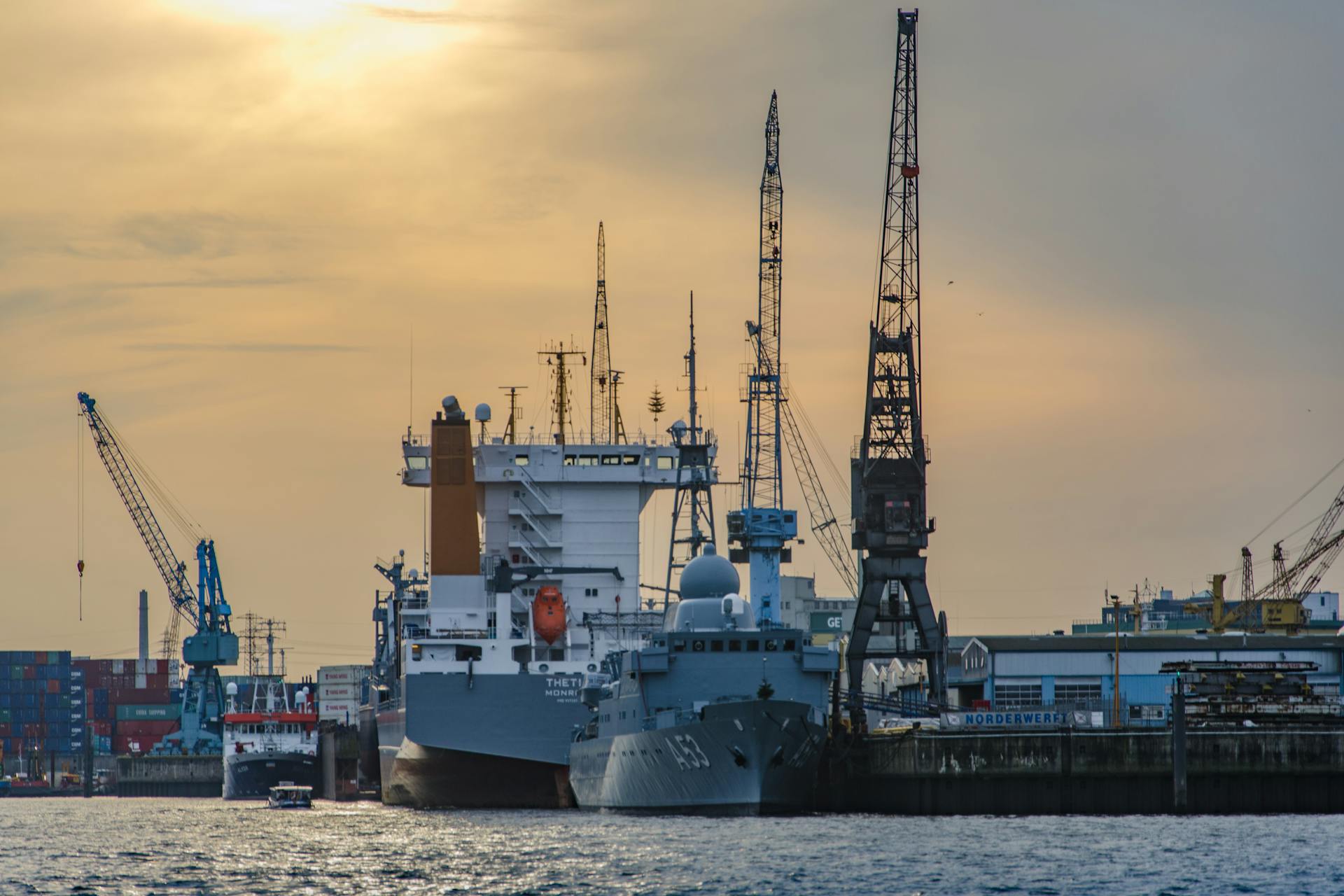
Here's a quick comparison of the two charter types:
Bareboat Charters
Bareboat Charters offer a high level of control and flexibility to charterers, allowing them to tailor the vessel to their needs. They account for roughly 10-15% of all charterparties in the shipping industry.
In a bareboat charter, the charterer has full control of the vessel, including crewing, maintenance, and insurance, for an agreed-upon period. The shipowner does not provide administration or technical maintenance.
The charterer assumes full responsibility for the vessel's operation, including crewing, maintenance, and all operational aspects. This arrangement offers the charterer the highest level of control and flexibility.
Here are the key features of Bareboat Charters:
- Transfer of operational control from the owner to the charterer
- Charterer assumes responsibility for crewing and crew management
- Charterer is liable for vessel maintenance and repair costs
- Charterer bears financial responsibility for third-party liabilities, such as collisions, personal injuries, and pollution damage
Bareboat charters can offer potential tax benefits and full operational control, but they also come with increased liabilities and responsibilities for the charterer.
Freight and Payments
The owner is responsible for the capital cost of building and equipping the ship, but who pays for the operating costs? With voyage and time charters, the owner pays the operating costs, while with demise charters, the charterer takes on this responsibility.
In voyage charters, the owner also pays for voyage costs, including fuel, canal dues, and port agency costs. However, in time and demise charters, the charterer is responsible for these costs.
With voyage charters, the owner is also responsible for cargo handling costs, such as loading and discharging the cargo. But with time and demise charters, the charterer covers these costs.
Here's a breakdown of who pays what in different types of charters:
Freight rates are crucial for ship charter profitability, and they can fluctuate based on market conditions, vessel details, and bunker prices. Charterers and shipowners must analyze charter costs thoroughly to enhance profitability.
Maritime Industry and Regulations
The maritime industry is poised for a transformative shift with ship charters at the core. As technology evolves and regulations change, the future of ship charters is both promising and challenging.
The evolving regulatory landscape is a key factor influencing the sector. The maritime industry is subject to various international and national regulations, and changes in these regulations can have a significant impact on ship charters.
Regulatory bodies such as the International Maritime Organization (IMO) play a crucial role in shaping the maritime industry's future. The IMO's regulations aim to promote safety, security, and environmental protection in the maritime sector.
The maritime industry must adapt to these changing regulations to remain competitive.
Recommended read: Broker for International Shipping
Evolving Regulations
The maritime industry is heavily regulated, and it's essential to stay informed about the evolving rules that shape the future of ship charters. The International Maritime Organization's (IMO) 2020 sulfur cap has significantly impacted ship charters, forcing stakeholders to reassess fuel strategies and invest in cleaner technologies.
The IMO 2020 regulation limits marine fuels' sulfur content to 0.5% globally, increasing operating costs and influencing vessel demand for charters. This shift towards low-sulfur fuels and emissions reduction has also led to a rise in costs, with estimates suggesting an additional $100,000 for a US Gulf Coast to EU round trip in the tanker sector.
The European Union's Emissions Trading System (EU ETS) is another regulatory development affecting ship charters. Vessels over 5,000 tons will need to surrender allowances for their carbon emissions, with the phase-in starting at 40% for intra-EU voyages and 20% for EU to non-EU voyages in 2024, increasing to 100% by 2028.
Here's a breakdown of the EU ETS emissions surrender requirements:
As the maritime industry adapts to these regulations, stakeholders must stay informed and adaptable to position themselves for success in the sustainable shipping era.
Technological Advancements Impacting
Digitalization and automation are revolutionizing the maritime industry, transforming ship charters with enhanced connectivity, knowledge sharing, operational efficiency, and corporate performance.
Smart contracts, powered by blockchain, are streamlining the chartering process, reducing transaction costs, and ensuring trust and transparency.
Technological advancements are also impacting data analytics in the maritime sector, allowing ship charterers and owners to optimize vessel performance with digital data on safety, emissions, and operational efficiency.
This data-driven approach is set to become a key differentiator in the competitive ship charter market, where digital data is available on various aspects of vessel performance.
Challenges and Considerations
Choosing the right charter type is just the beginning - you also need to navigate the challenges that come with it. Market volatility is a major concern, causing freight rates to fluctuate wildly, making cost prediction difficult.
Companies with consistent shipping needs often prefer time charters for their cost predictability and vessel availability. However, this comes with the risk of unused capacity, which can be a significant challenge.
Risk mitigation is another significant challenge, as both charterers and shipowners must comply with complex legal and regulatory requirements while managing maritime risks. Effective contract negotiation and performance monitoring are vital for a successful chartering experience.
The choice between time and voyage charters depends on a company's specific needs, risk tolerance, and market conditions. Understanding the distinct characteristics of each charter type is crucial for making informed decisions.
Here's a comparison of the key differences between time and voyage charters:
By understanding these key differences and considering the challenges involved, companies can make informed decisions that enhance their shipping operations and financial outcomes.
Frequently Asked Questions
What is charter cost in shipping?
The charter cost in shipping is a fixed fee agreed upon before a voyage, calculated based on cargo weight, volume, or distance, and influenced by market conditions. Understanding charter cost is crucial for optimizing shipping operations and managing logistics costs effectively.
What does it mean when a ship has been chartered?
A ship has been chartered when it's leased or hired by a charterer for a specific period to transport goods or passengers. This arrangement gives the charterer control over the vessel's use and operations during the charter period.
What is a vessel charter agreement?
A vessel charter agreement is a contract between a ship owner and a merchant for the temporary use of a ship for a specific voyage or trip. It outlines the terms and conditions of the charter, including the duration, cargo capacity, and payment details.
Sources
- https://www.oneocean.com/insights/the-ins-and-outs-of-ship-chartering
- https://www.marineinsight.com/maritime-law/ship-chartering-process-the-ultimate-guide/
- https://www.maritimeoptima.com/shipping-academy/ship-chartering
- https://www.virtuemarine.nl/post/ship-charters-types-differences-merits-of-each-type
- https://www.linkedin.com/pulse/shipping-liner-charter-ships-how-works-stusupplychain
Featured Images: pexels.com


